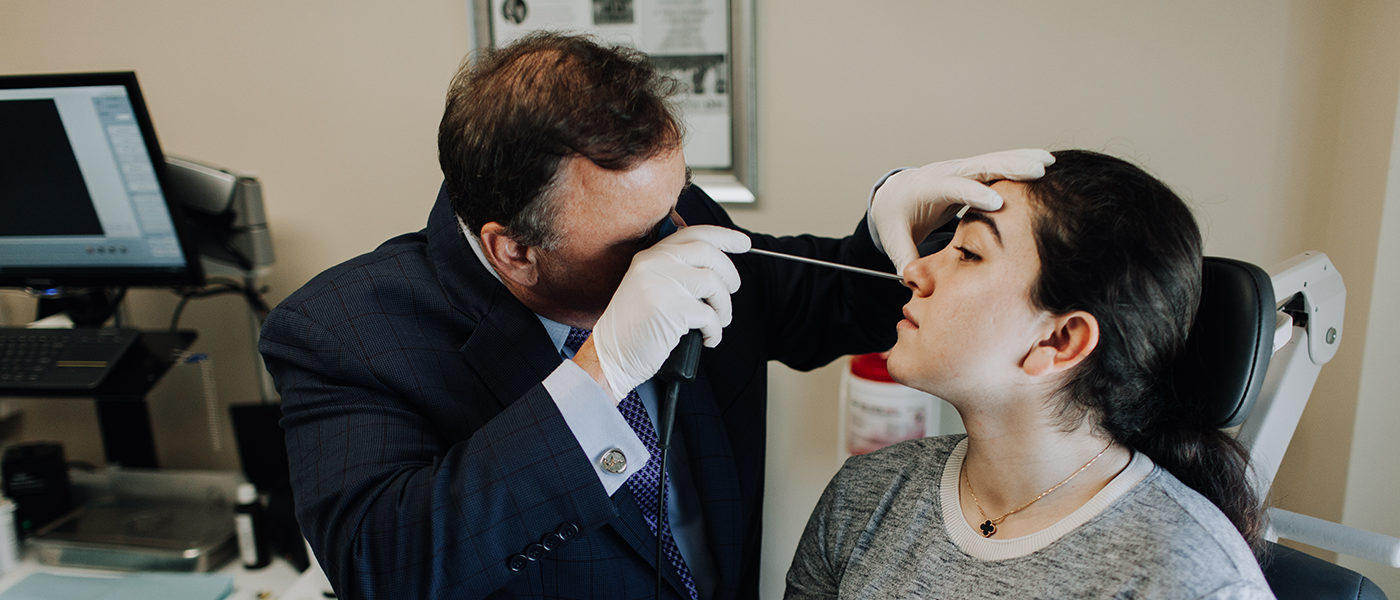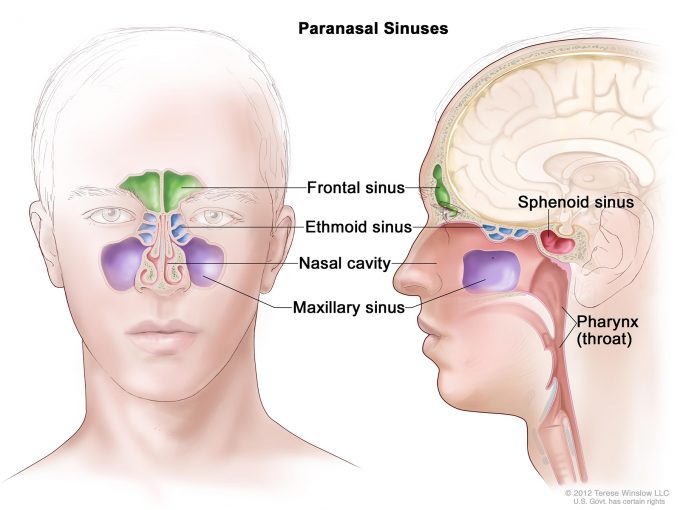
Nose Conditions
Nose & Sinus Conditions We Treat
These are treated by our Pacific Head & Neck Specialists and include the following:
Allergies
Allergies occur when the immune system reacts to foreign substances, such as pollen, pet dander, or certain foods, that are typically harmless to most people. This reaction can lead to symptoms ranging from mild, such as sneezing, itching, and rashes, to severe, like anaphylaxis, which is a life-threatening emergency. Common allergens include pollen, dust mites, mold, insect stings, pet dander, and certain foods like nuts, shellfish, and dairy.
Nasal obstruction
Nasal obstruction refers to a blockage of the nasal passages, often resulting in difficulty breathing through the nose. Common causes include nasal congestion from colds, allergies, or sinus infections, as well as structural issues such as a deviated septum or nasal polyps. Symptoms can include a stuffy or runny nose, snoring, and reduced sense of smell. Treatment depends on the underlying cause and may involve medications like decongestants or antihistamines, nasal sprays, or surgery for structural problems.
Nasal masses
Nasal masses are abnormal growths within the nasal cavity, which can be benign or malignant. Common types include nasal polyps, cysts, and tumors. Symptoms often include nasal obstruction, congestion, nosebleeds, reduced sense of smell, and facial pain. Causes range from chronic inflammation due to allergies or infections to genetic factors and, less commonly, malignancies. Diagnosis typically involves a physical examination, nasal endoscopy, and imaging studies like CT scans or MRIs. Treatment depends on the type and cause of the mass, and may include medications, such as steroids, or surgical removal.
Acute/chronic sinusitis
Acute sinusitis is a short-term inflammation of the sinuses, often triggered by a cold or bacterial infection, lasting up to four weeks. Symptoms include nasal congestion, facial pain, pressure, and thick nasal discharge. Chronic sinusitis, on the other hand, persists for 12 weeks or longer and can be caused by ongoing infections, allergies, or structural issues in the nasal passages. Symptoms are similar but last longer and can significantly impact quality of life. Treatment may involve decongestants, nasal corticosteroids, antibiotics, or surgery in severe cases.
Snoring / sleep apnea
Snoring is a common condition caused by the vibration of tissues in the throat during sleep, leading to noisy breathing. While often harmless, it can indicate obstructive sleep apnea (OSA), a serious disorder where breathing repeatedly stops and starts during sleep. Symptoms of OSA include loud snoring, gasping for air, daytime fatigue, and restless sleep. Risk factors include obesity, nasal congestion, and a narrowed airway. Diagnosis typically involves a sleep study. Treatments range from lifestyle changes, such as weight loss, to medical interventions like Continuous Positive Airway Pressure (CPAP) therapy or surgery.
Headaches related to the nose
Headaches related to the nose, often referred to as sinus headaches, are typically caused by inflammation or congestion in the sinuses. This can result from infections, allergies, or structural issues like a deviated septum. The pain is usually felt in the forehead, around the eyes, and in the cheeks, often intensifying with movement or pressure changes. Sinus headaches are frequently accompanied by other symptoms such as nasal congestion, discharge, and facial pressure. Treatment may involve decongestants, antihistamines, nasal sprays, or antibiotics if a bacterial infection is present.
Nose bleeds/collapse
Nosebleeds, or epistaxis, can occur due to various factors, including trauma, dry air, allergies, infections, or underlying medical conditions. The nasal septum, the cartilage dividing the nostrils, can become weakened or damaged, leading to a collapse, which can obstruct airflow and cause breathing difficulties. Frequent nosebleeds might indicate a structural issue or a tendency for the nasal tissue to bleed easily. Treatment for nosebleeds involves pinching the nose, using nasal sprays, or cauterization for persistent cases. Septal collapse may require surgical intervention to restore proper nasal structure and function.
Smell/taste disorders
Smell and taste disorders can significantly impact a person’s quality of life, affecting their ability to enjoy food and detect hazards such as smoke or gas leaks. These disorders can result from various causes, including viral infections (like COVID-19), nasal polyps, head injuries, neurological conditions, or certain medications. Common types include anosmia (loss of smell), hyposmia (reduced smell), dysgeusia (distorted taste), and ageusia (loss of taste). Diagnosis often involves a thorough medical history, physical examination, and sometimes imaging studies. Treatment depends on the underlying cause and may include medications, surgery, or olfactory training to help restore the senses.
Facial pain/headaches
Facial pain and headaches can be debilitating, often resulting from a variety of causes such as sinus infections, migraines, tension headaches, dental issues, or neuralgia. This pain may manifest in different regions of the face, including the forehead, cheeks, jaw, or around the eyes, and can range from sharp and shooting to dull and throbbing. Accurate diagnosis often requires a comprehensive evaluation, including a physical examination and sometimes imaging studies. Treatment varies based on the cause and can involve medications, lifestyle changes, physical therapy, or surgical interventions to alleviate symptoms and address the root cause of the pain.
Nose Procedures
- Functional septorhinoplasty
- Image-guided endoscopic sinus surgery
- In-office balloon sinuplasty
- Liquid rhinoplasty
- Nasal polyp removal
- Nasal & septal fractures
- Radiofrequency reduction of inferior turbinates
- Repair of nasal collapse
- Repair of septal perforations
- Rhinoplasty (cosmetic nose surgery)
- Septoplasty (deviated septum)
- Taste & smell disorders
- Treatment of nosebleeds (epistaxis)
Tumors of the Nose
Tumors in the nose and sinus cavities (sinonasal tumors) are rare and account for only about 10 percent of all head and neck tumors. Sinonasal tumors can develop from any of the structures in the nose including the epithelial lining, blood vessels, nerves, and bone or cartilage. These tumors affect the nasal cavity and paranasal sinuses. In addition, depending on size and location, they may cause issues within the pituitary area leading to a number of symptoms related to hormonal levels controlled by the pituitary gland.
We Provide Expert Medical Care for Nasal Conditions
Pacific Eye, Ear & Skull Base Center’s experts treat a wide range of diseases that affect the nasal cavity and paranasal sinuses.

Our head & neck surgeons and neurosurgeons are specialized in the treatment of conditions requiring minimally invasive endoscopic sinus surgery.
These include:
Pituitary and skull base tumors
Benign sinonasal tumors tend to grow slowly and stay localized without spreading to adjacent structures. These are the most common tumors found in the sinonasal cavity. Malignant sinonasal tumors are very rare accounting for about 2000 cases being diagnosed in the United States. Fortunately, most of these tumors can now be removed through one of several keyhole routes depending upon tumor location and size.
